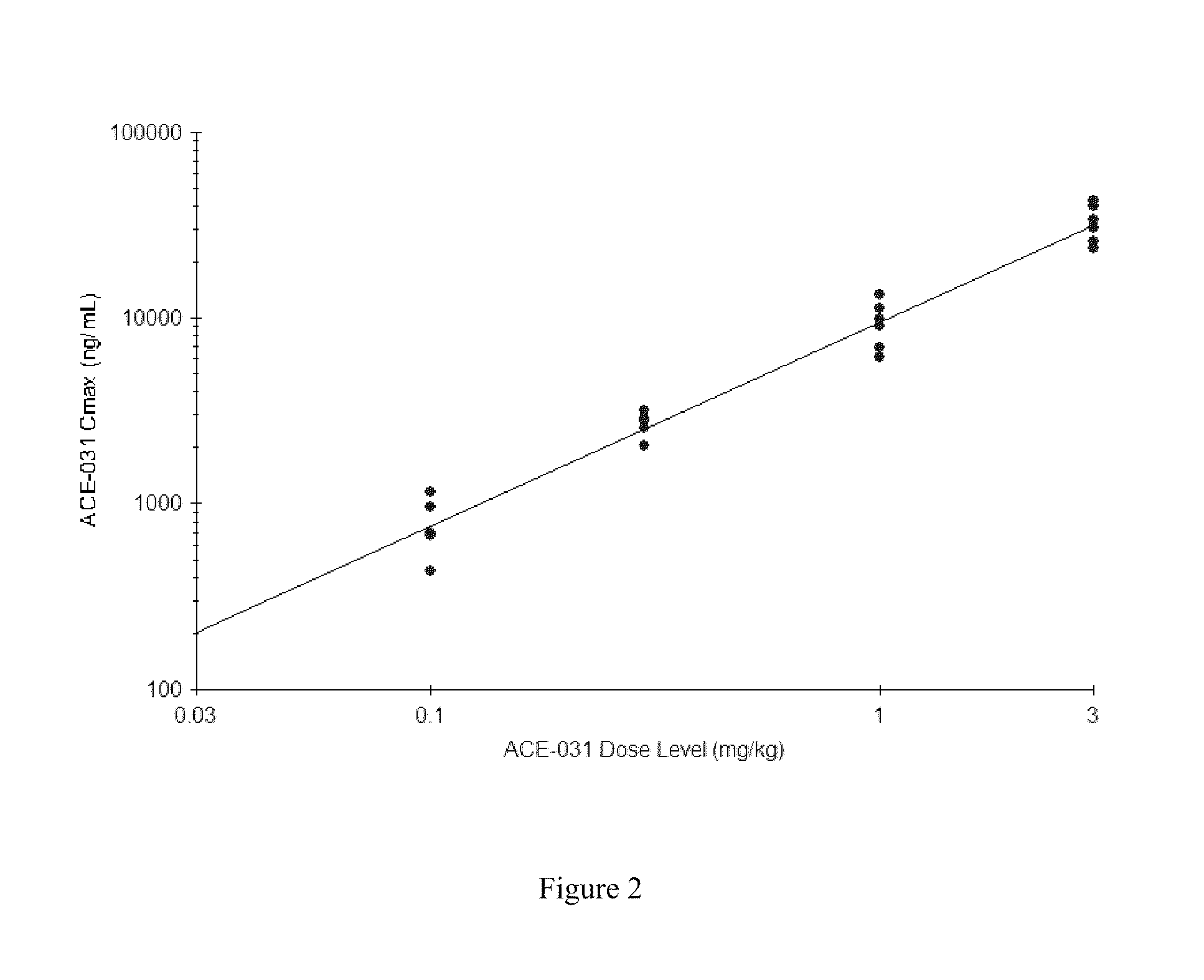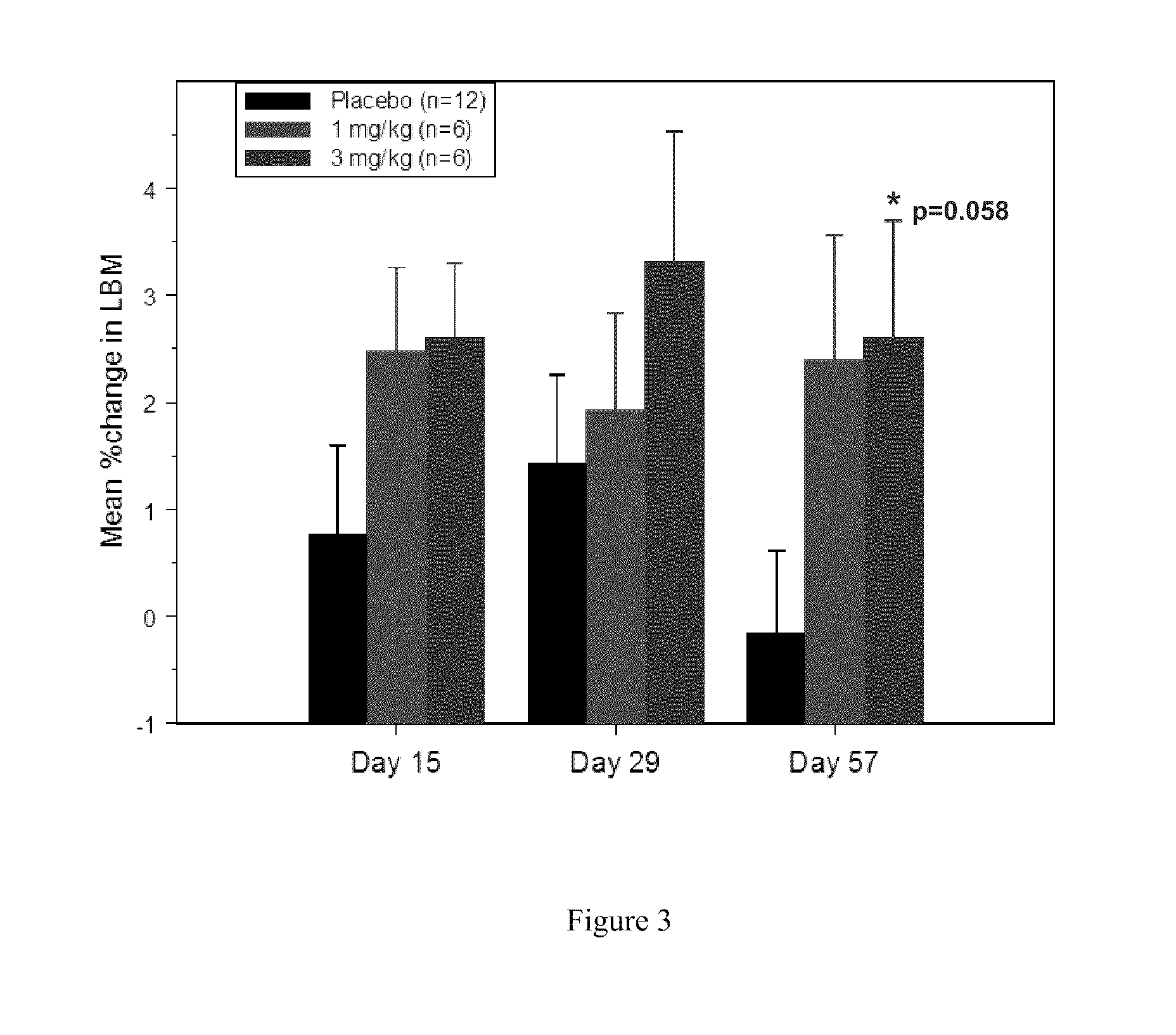Actriib antagonists and dosing and uses thereof
a technology of actriib and antagonist, which is applied in the direction of antibody medical ingredients, extracellular fluid disorder, peptide sources, etc., can solve the problems of significant medical problems, imbalances in the normal bone remodeling process, and often associated side effects of therapeutics, so as to promote bone growth, increase bone density, and increase bone strength
- Summary
- Abstract
- Description
- Claims
- Application Information
AI Technical Summary
Benefits of technology
Problems solved by technology
Method used
Image
Examples
example 1
ActRIIb-Fc Fusion Proteins
[0183]Applicants constructed a soluble ActRIIb fusion protein that has the extracellular domain of human ActRIIb fused to a human or mouse Fc domain with a minimal linker (three glycine amino acids) in between. The constructs are referred to as ActRIIb-hFc and ActRIIb-mFc, respectively.
[0184]ActRIIb-hFc is shown below as purified from CHO cell lines (SEQ ID NO: 13)
GRGEAETRECIYYNANWELERTNQSGLERCEGEQDKRLHCYASWRNSSGTIELVKKGCWLDDFNCYDRQECVATEENPQVYFCCCEGNFCNERFTHLPEAGGPEVTYEPPPTAPTGGGTHTCPPCPAPELLGGPSVFLFPPKPK
[0185]The ActRIIb-hFc and ActRIIb-mFc proteins were expressed in CHO cell lines. Three different leader sequences were considered:
(i) Honey bee mellitin (HBML): MKFLVNVALVFMVVYISYIYA (SEQ ID NO: 14)
(ii) Tissue Plasminogen Activator (TPA): MDAMKRGLCCVLLLCGAVFVSP (SEQ ID NO: 15)
[0186](iii) Native: MGAAAKLAFAVFLISCSSGA (SEQ ID NO: 16).
[0187]The selected form employs the TPA leader and has the following unprocessed amino acid sequence:
(SEQ ID NO: 17)MDAMKRGLCC...
example 2
Generation of ActRIIb-Fc Mutants
[0192]Applicants generated a series of mutations in the extracellular domain of ActRIIb and produced these mutant proteins as soluble fusion proteins between extracellular ActRIIb and an Fc domain. The background ActRIIb-Fc fusion has the sequence (Fc portion underlined) (SEQ ID NO:20):
SGRGEAETRECIYYNANWELERTNQSGLERCEGEQDKRLHCYASWRNSSGTIELVKKGCWLDDFNCYDRQECVATEENPQVYFCCCEGNFCNERFTHLPEAGGPEVTYEPPPTAPTGGGTHTCPPCPAPELLGGPSVFLFPPKP
[0193]Various mutations, including N- and C-terminal truncations, were introduced into the background ActRIIb-Fc protein. Based on the data presented in Example 1, it is expected that these constructs, if expressed with a TPA leader, will lack the N-terminal serine. Mutations were generated in ActRIIb extracellular domain by PCR mutagenesis. After PCR, fragments were purified through a Qiagen column, digested with SfoI and Agel and gel purified. These fragments were ligated into expression vector pAID4 (see WO2006 / 012627) such t...
example 3
Bioassay for GDF-11 and Activin-Mediated Signaling
[0198]An A-204 Reporter Gene Assay was used to evaluate the effects of ActRIIb-Fc proteins on signaling by GDF-11 and Activin A. Cell line: Human Rhabdomyosarcoma (derived from muscle). Reporter vector: pGL3(CAGA)12 (Described in Dennler et al, 1998, EMBO 17: 3091-3100.) See FIG. 1. The CAGA12 motif is present in TGF-Beta responsive genes (PAI-1 gene), so this vector is of general use for factors signaling through Smad2 and 3.
[0199]Day 1: Split A-204 cells into 48-well plate.
[0200]Day 2: A-204 cells transfected with 10 ug pGL3(CAGA)12 or pGL3(CAGA)12(10 ug)+pRLCMV (1 ug) and Fugene.
[0201]Day 3: Add factors (diluted into medium+0.1% BSA). Inhibitors need to be preincubated with Factors for 1 hr before adding to cells. 6 hrs later, cells rinsed with PBS, and lyse cells.
[0202]This is followed by a Luciferase assay. In the absence of any inhibitors, Activin A showed 10 fold stimulation of reporter gene expression and an ED50˜2 ng / ml. GDF...
PUM
| Property | Measurement | Unit |
|---|---|---|
| concentration | aaaaa | aaaaa |
| concentration | aaaaa | aaaaa |
| concentration | aaaaa | aaaaa |
Abstract
Description
Claims
Application Information
 Login to View More
Login to View More - R&D
- Intellectual Property
- Life Sciences
- Materials
- Tech Scout
- Unparalleled Data Quality
- Higher Quality Content
- 60% Fewer Hallucinations
Browse by: Latest US Patents, China's latest patents, Technical Efficacy Thesaurus, Application Domain, Technology Topic, Popular Technical Reports.
© 2025 PatSnap. All rights reserved.Legal|Privacy policy|Modern Slavery Act Transparency Statement|Sitemap|About US| Contact US: help@patsnap.com



